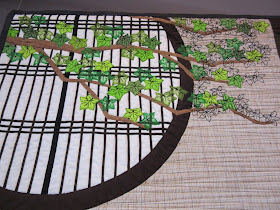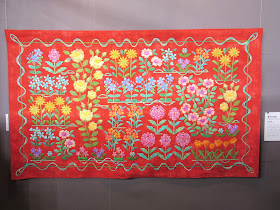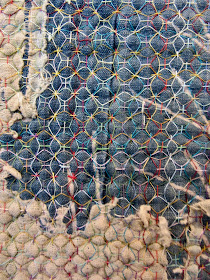We are looking at the professionals' quilts. 'Sensei' is the title for masters or teachers or other pros whom you look up to. Many of the Japanese quilt 'senseis' specialize in only one type of quilt and have honed their skills and never venture into another style of quilting.
In the last blog post we looked at a quilt with Cathedral Windows and how it had inspired Julie, Tanya and self into taking on the challenge of trying out that style for next year.
We got even more inspiration when we saw
EIKO OKANO's (岡野栄子)fantastic Cathedral Window kimono quilt. It is called Edo Kiriko, which is the cut glass of Tokyo.


As far as I know this is the first CW quilt Ms Okano has made, but she has made many quilts in the shape of a kimono and almost all her quilts feature a mass of small buttons.
In my opinion this quilt was one of the best at the show.
A 'sensei' who is highly commended for her PERFECT appliqué is KEIKO MIYAUCHI (宮内恵子)
She is also very colour confident and there is always both contrast and gradation in her work.
MACHIKO MIYATANI's (宮谷真知子) genre is Crazy Quilting, but very 'sane' or controlled such.
If I have got it right Ms Miyatani comes from a tailoring family and have probably learned how to cut, insert pieces and stitch with precision.

This year she showed a unique quilt. The pattern is that of Ainu the indigenous people of Japan. The pattern had been painted on the fabric (I think!), and then stitched and embroidered.
Julie was instantly drawn to this design as she is planning to work the lining of her Mola waist coat with Ainu designs to make it a reversible garment.
NORIKO MASUI's (升井紀子) style is Medallion Quilts. Her hallmark? Fussy cutting of fabric, balancing the colour palette and precise stitching.


I am drawn to her quilts with magnetic force!
YOSHIKO KURIHARA (栗原淑子) won the Grand Prix one year and has since then produced one quilt after another with geometric people. Here are people in Tokyo in summer.

NAOKO TAKESHITA (竹下直子) calls her creation 'In The Kimono Chest of Drawers...' so I guess this quilt is made from recycled kimono fabric, although it doesn't look it. There is no question about the attention to details and high level of craftsmanship, though.
Don't you think blue and brown, light blue and cream make such a beautiful combination?




Someone who HAS used kimono scraps for her quilt is TAEKO SHINOZAKI (篠崎妙子)

Scraps of kimono were used for this quilt, too, by MICHIKO SONOBE (園部美知子)

HIROKO KOIKE (古池裕子) is another stitcher with skills extraordinaire.

There is always a crowd around YOKO SEKITA's (関田陽子) amusing quilts. So many details, so much of Japanese culture, such skill at handling the tricky kimono silk for the tiny appliqué as well as the charming and humorous scene.

Here is The Foxs wedding. The poor bride in her white kimono sits forlornly and angrily by the sake cup (used for the wedding vows) while the bridegroom has fallen asleep in a drunken stupor together with the matchmaker whose wife is trying to tug him awake.


Ms Sekita loves Alice in Wonderland, and has invited Alice and the Mad Hatter as wedding guests. Alice is tangled up in a kimono with a mask in front of her face.
These quilts are a bit like Where's Wally? and visitors flock around Ms Sekita's quilts to look for Alice.
JUNKO SAWADA (沢田淳子) celebrates Japanese architecture, the tea room with its kettle, paper window and flower arrangement on the wall.

In the garden, there is raked sand, and islands of rock, like the famous Ryoanji garden in Kyoto.

Kimono fabric mixed with quilters cotton, and then machine stitched.

MITSUYO AKITA (秋田光代) made a quilt with two men dancing the Lion Dance.

The expression BORO for quilts made of rags has inspired quilters to make use of every little piece of fabric there is in some way or other.
KIYOKO HARADA (原田清子) used the red silk rags in her stash with a sprinkling of gold and green and ....

Silk waste, odd strings, beads and sequins also found a home here.

The ultimate ragged quilt was this blue and brown one by
SATOKO OKAMURA (岡村智子)

Look at the quilting! I have never seen anything like this - laced quilting in variegated thread!
With such fraying edges on the patches you do need tight netlike quilting, though.
Here, however, is a three-paneled quilt by YOKO UEDA (上田陽子) that is made entirely of new fabric, it is beautifully shaded and accented with metallic waves. The setting sun on waves!
Julie, Tanya and Pamela. Thank you!
Finally I would like to share with you a few photos of the antique quilts in Ms Takako Onoyama's collection. Do you remember? She is the lady who opened the first quilt shop in Japan, Quilt House Yama. I wrote about it here.


Look at this! Isn't it a lovely crazy quilt?
There is a special reason why I added these three photos as the last of my visit to Tokyo International Great Quilt Festival 2018. More about that in my NEXT blogpost!










These quilts are stunning. Many thanks for taking us along to the show.
ReplyDeleteNext year I want to walk around the show together with you!
DeleteHi Carin, thanks again for this fabulous post : I must admt that my favorite is the quilt of YOKO SEKITA San : it is so japanese and amusing : I like it very much !
ReplyDeleteHave a lovely day,
Cheers,
isa
Yoko Sekita's quilt is great and hard to see as there are so many standing around it drooling.
DeleteThank you for this post! I’m behind in my blog reading and need to look back at parts 1-5. I love that red silk boro inspired quilt.
ReplyDeleteHi Cynthia
DeleteHow nice to hear from you! I hope you think of Julie and me and the time we spent together in Tokyo when you see these photos.
It would be lovely to see you in Tokyo Dome at next year's show!
That netlike quilting does look very intriguing - I'm sure it could be used in a multitude of ways!
ReplyDeleteI have never seen such quilting - most unique. It certainly held those very worn pieces in check.
DeleteThe laced quilting is a show stopper!
ReplyDeleteI think that's one of the best quilt shows on the planet. Where else do you see such
handwork, design and use of color?
Thank you, Carin.
There is so much to see at this show, quilts that are perfect copies of book covers, quilts full of new interpretations and quilts were scrap fabric has been used to full advantage.
DeleteI'm pleased you included close ups of the work, it is beautiful.
ReplyDeleteThey often joke about the 'quilt police', 'rival' quilters who go round and look for things to complain about. These quilts can be studied with a magnifying glass and no flaws found.
DeleteThat "Quilt House Yama"was one of the best fabric shops in Kichioji and I never went to the area without stopping in. I remember when the sensei had cancer and her deshi kept the shop going. I was so sad when it finally closed. Now I am thinking of how to put cathedral blocks into a crazy quilt....
ReplyDeleteAlthough I never visited the shop (not in my neck of the woods) I know it was an iconic shop. It is so sad that many actual shops disappear and we are forced to do online shopping. OR wait a year and go the the traders at the show!
DeleteThank you so much for your posts about the quilt show. I have been wanting to go to this for years but January is my busy time for teaching Children's Class. This year I taught most days. The quilts are stunning.
ReplyDeleteIt is a show worth visiting and we did see quite a number of Australians (on a quilt tour). I agree January is not the best month for me either to go to a show. I hope one day you can make it; maybe with your students!
DeleteThanks for sharing the quilts from the quilt show. So much superb craftsmanship! This is as close as I will ever come to the show so I appreciate all the photos. Love that Fox wedding!
ReplyDeleteThe Foxs wedding is even nicer in the flesh when all the sheen from the kimono silk can be enjoyed. The camera can just not make it justice.
DeleteBeautiful photos and commentary! I have yet to download my quilt show photos, but hope to catch up over the weekend.
ReplyDeleteI am looking forward to your photos.
DeleteYou did such a great job of photographing the quilt show! I seem to have only gotten a corner or two and didn't see half of the things you took photos of! Next year I'm going to have to figure out how to spend even more time at the show with you.
ReplyDeleteYou have to stay the night, that's it!
DeleteIt takes two days, at least, to take in the show.
My photos can't compete with yours in colour or clarity, but they show the variety of quilts.
Such a wide variety of stiles, they are all beautiful!
ReplyDeleteIt is like being in a sweet shop, the size of a department store!
Delete